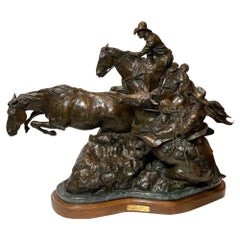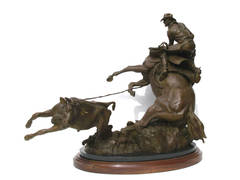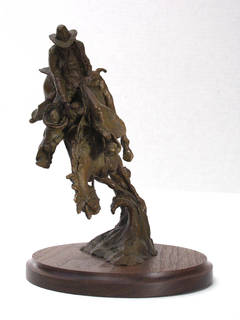Herb Mignery Sculptures
Late 20th Century American Animal Sculptures
Bronze
Recent Sales
Bronze
Bronze
1980s Impressionist Figurative Sculptures
Bronze
2010s Realist Still-life Sculptures
Bronze
People Also Browsed
20th Century British Victorian Sofas
Leather, Beech
20th Century American Realist Figurative Sculptures
Bronze
Vintage 1920s Austrian Machine Age Figurative Sculptures
Bronze
Antique 19th Century French Animal Sculptures
Bronze
Vintage 1920s Austrian Other Figurative Sculptures
Bronze
Antique Early 18th Century British George I Grandfather Clocks and Longc...
Walnut
Antique 18th Century English George I Grandfather Clocks and Longcase Cl...
Brass, Steel
Herb Mignery for sale on 1stDibs
Herb Mignery was raised on a working cattle ranch near Bartlett, Nebraska. Rather than follow his family’s 110 year tradition of ranching, Mignery turned his childhood interest in drawing into a successful career in the commercial art world before devoting himself full time to fine art. An award-winning member of the Cowboy Artists of America, his elegant and classically rendered sculptures chronicle the lives of men and women as they wrestled the land and elements of the early American West. Each of Mignery’s sculptures completes a piece of the story of life in the West. Mignery is a member of the Cowboy Artists of America, the National Sculptors' Guild, as well as the National Sculpture Society of America. His small scale and monumental bronze sculptures are in private and corporate collections across the country. Mignery has also completed several lifesize sculptures for permanent public installations.
Finding the Right Sculptures for You
The history of sculpture as we know it is believed to have origins in Ancient Greece, while small sculptural carvings are among the most common examples of prehistoric art. In short, sculpture as a fine art has been with us forever. A powerful three-dimensional means of creative expression, sculpture has long been most frequently associated with religion — consider the limestone Great Sphinx in Giza, Egypt — while the tradition of collecting sculpture, which has also been traced back to Greece as well as to China, far precedes the emergence of museums.
Technique and materials in sculpture have changed over time. Stone sculpture, which essentially began as images carved into cave walls, is as old as human civilization itself. The majority of surviving sculpted works from ancient cultures are stone. Traditionally, this material and pottery as well as metal — bronze in particular — were among the most common materials associated with this field of visual art. Artists have long sought new ways and materials in order to make sculptures and express their ideas. Material, after all, is the vehicle through which artists express themselves, or at least work out the problems knocking around in their heads. It also allows them to push the boundaries of form, subverting our expectations and upending convention. As an influential sculptor as much as he was a revolutionary painter and printmaker, Pablo Picasso worked with everything from wire to wood to bicycle seats.
If you are a lover of art and antiques or are thinking of bringing a work of sculpture into your home for the first time, there are several details to keep in mind. As with all other works of art, think about what you like. What speaks to you? Visit local galleries and museums. Take in works of public art and art fairs when you can and find out what kind of sculpture you like. When you’ve come to a decision about a specific work, try to find out all you can about the piece, and if you’re not buying from a sculptor directly, work with an art expert to confirm the work’s authenticity.
And when you bring your sculpture home, remember: No matter how big or small your new addition is, it will make a statement in your space. Large- and even medium-sized sculptures can be heavy, so hire some professional art handlers as necessary and find a good place in your home for your piece. Whether you’re installing a towering new figurative sculpture — a colorful character by KAWS or hyperreal work by Carole A. Feuerman, perhaps — or an abstract work by Won Lee, you’ll want the sculpture to be safe from being knocked over. (You’ll find that most sculptures should be displayed at eye level, while some large busts look best from below.)
On 1stDibs, find a broad range of exceptional sculptures for sale. Browse works by your favorite creator, style, period or other attribute.


